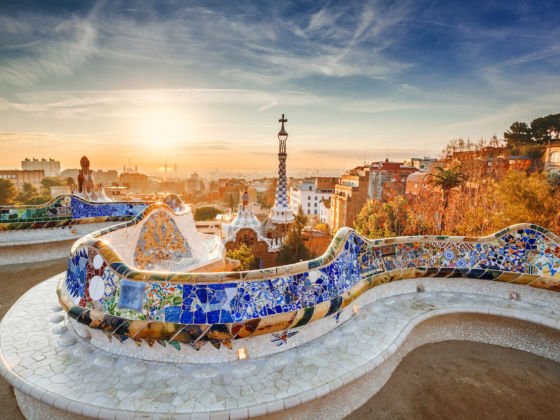

Vibrant, seaside Barcelona is the ultimate capital of culture and relaxation. Set between coastal mountains and the Mediterranean, it has world-class museums, bustling outdoor cafes, and an all-night party scene, as well as miles of beaches and hiking trails. Barcelona also has a laid-back attitude so seductive that, once you arrive, you won’t want to leave. Find out how to make the best of your time here with this ultimate guide of the city.
Barcelona is located right on the Mediterranean sea, which makes the climate mild and pleasant year round. However, it does have a winter season that goes from December to March. While it doesn’t usually snow, it rains and temperatures can drop to the mid 40s. The advantage of “braving” this weather is that the city is much less crowded and hotel prices are lower.
Summer is truly when things start to heat up — literally. Between June and September, expect to see giant tour groups downtown every single day. The beach is poppin’ thanks to the well-groomed sand, cold sangria, and temperatures up in the 80s. Barcelona doesn’t overheat because of its access to the Mediterranean Sea, but August can get pretty uncomfortable. Expect your shirt to be stuck to your back.
If all of this sounds too extreme, consider traveling in the shoulder season, when accommodation is more affordable than it is in the summer. Fall in Barcelona (September through November) and is still sunny and warm, but you won’t be sweating profusely and the tourist crowds won’t be quite as overwhelming. Spring (March through May) is also a lovely time; trees are blooming, street performers are making their way back to the plazas, and it’s still not too crowded — just be aware of spring breakers.
As a European Union country, Spain uses the euro. The conversion is about €0.85 per 1 USD. Credit cards are accepted at most places, but it’s always a good idea to have some cash handy for flea markets or old-school restaurants that don’t accept cards — which is a surefire sign the restaurant is going to be authentic and delicious.
Tips are not required in Barcelona, though if you receive good service, leaving anywhere between 10 and 20 percent would be appreciated. Avoid restaurants that give you massive laminated menus in a dozen languages; these are tourist traps that will probably expect tourist tips -- and the food is definitely going to suck.
You may not know this, but the official language here is Catalan. As a romance language derived from Latin, it shares many similarities with Spanish as you know it (aka Castellano), but if you only got up to 8th grade Spanish, you’re likely to be confused if you’re listening into locals’ conversations. That said, everyone can speak Castellano, so communicating won't be an issue, and signs usually have both Spanish and Catalan. Most people can also speak English, so don’t stress out over a language barrier. Though it doesn’t hurt to know a few of these useful phrases (and some risqué slang) because it turns out that you don’t actually use “¿dónde está la biblioteca?” (“where is the library?”) as much as middle school led you to believe.
Barcelona is an easy-to-navigate, pedestrian paradise. This is why you’ll see us rocking sneakers and keeping the high heels for weekend use only (and even then, we’re packing flat shoes in our bag). For a truly local experience and a whole lot of exercise to work off all of those tapas, explore the city on foot. You’re likely to discover some local haunts and run into cool street art. You can also rent a bike for as low as €5 per day, which is great for a quick jaunt to the beach.
If you have a long distance to conquer, public transportation is a dependable option. The metro is clean, cheap, and runs on time. Upon arrival, you should get a T-10 card for €10.30. That gives you 10 rides, which should be enough for one person for a week. As a note, be extra careful of your belongings on the metro because pickpockets are extremely skilled here. Trains that run out of town, to destinations like Sitges, Girona or Montserrat, are also super reliable and cheap.
If you prefer to ride comfortably, just hail one of the dozen cabs that drive by every minute. Make sure it’s metered so you’ll know exactly how much you’re paying, or agree on a fare before you get into the vehicle. Alternatively, Uber recently made its way back into the city, after disappearing for three years due to taxi driver protests.
The most cost-effective way to get to and from the airport is via the Aerobus at €5.90 per ticket. It drives between the city center and main terminal in around 35 minutes, and it operates year round.
Barcelona is a very safe city, with an overall low risk of danger when it comes to public transportation, mugging, and violence against women. But like any other major city, it’s important to stay alert and make the same smart decisions you would anywhere.
Fideuà is paella's little sister, a seafood dish that uses hollow noodles instead of rice.
Not quite legal, but not illegal.
There are few things more fun these days than meeting up with friends in a new city, especially in Europe. From Barcelona to Rome to Athens, Europe’s hottest destinations are all easily accessible with nonstop flights from Norwegian Air. Make your next meetup something special.